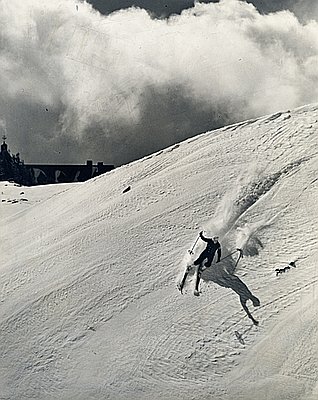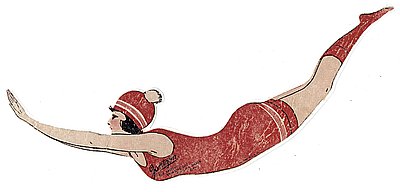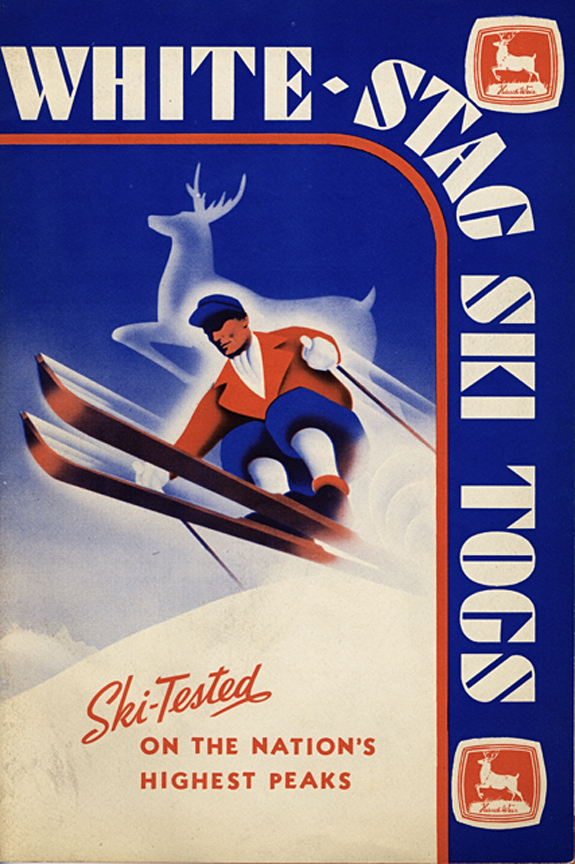- Catalog No. —
- ba018650
- Date —
- circa 1939
- Era —
- 1921-1949 (Great Depression and World War II)
- Themes —
- Arts, Sports and Recreation, Trade, Business, Industry, and the Economy
- Credits —
- Business Collection, Mss 1510, Oregon Historical Society Research Library
- Regions —
- Portland Metropolitan
- Author —
- Hirsch-Weis Manufacturing Company
White Stag Catalog Cover
This White Stag catalog cover from approximately 1939 features artwork of a skilled skier with the company's trademark, a leaping stag, in the background. In 1939, White Stag was the name for the sportswear division of Hirsch-Weis Manufacturing Company, a maker of canvas and durable work clothes. When the company began making ski "togs," or clothing, during the early years of the Great Depression, it became one of the first companies in the United States to manufacture and mass-produce clothing specifically designed for recreational skiing.
The company that became White Stag originated as a business that specialized in sails for deepwater ships. Henry Wemme established the Willamette Tent and Awning Company in 1883 and sold it to brothers Max S. and Leopold B. Hirsch in 1907. Harry Weis, Wemme's secretary, stayed with the company following the transfer of ownership. Appreciative of Weis's knowledge about canvas products, the Hirsch entrepreneurs asked him to become a partner, and soon the company was known as the Hirsch-Weis Manufacturing Company. As commercial sailing ships became obsolete, the partners expanded to make durable clothing and supplies for outdoor workers such as loggers, mill hands, and stockmen.
Max Hirsch's son, Harold S. Hirsch, created the White Stag line after returning to Portland as a Dartmouth University graduate in 1929. Harold had just started graduate work in Cultural Anthropology at Oxford University when the stock market crash compelled him to come home. Not an expert in textiles, Harold fell back on experience he gained as a former member of the Dartmouth ski team. In a corner of the Hirsch-Weis factory, he began work on a ski suit, which he marketed in 1931 as "White Stag," an English translation of the German words, "Hirsch" and "Weis."
Skiing in Oregon was on the rise in the 1930s, and the White Stag brand quickly gained a reputation, especially in western states. After World War II, the sport skyrocketed in popularity and, with it, White Stag ski clothing. As the sportswear division of Hirsch-Weis Manufacturing Company overcame the popularity of the company itself, officials changed its name to White Stag in 1956. By 1966, White Stag was a public company, and owners of the controlling stock - primarily the Hirsch family and other relatives - merged it with a conglomerate called Warner Brothers, a nationwide apparel and textile firm that later changed its name to Warnaco, Inc. Warnaco, Inc., in turn, sold the trademark to Wal-Mart Stores, Inc. in 2003.
Further reading:
Oral history interviews with Harold Hirsch. Interview conducted by Shirley Tanzer,1977 & 1978. Oregon Historical Society, SR 0354.1.
Written by Sara Paulson, © Oregon Historical Society, 2007.
Related Historical Records
-
Skier at Timberline Lodge
This photograph appeared in the Oregon Journal under a banner headline announcing the November 6 opening of the 1938 winter skiing season on Mt. Hood. An accompanying article …

-
Jantzen Red Diving Girl
The "Red Diving Girl," a corporate logo of the Jantzen Knitting Mills, was a highly effective marketing tool in the 1920s and helped the young Oregon-based company gain …

